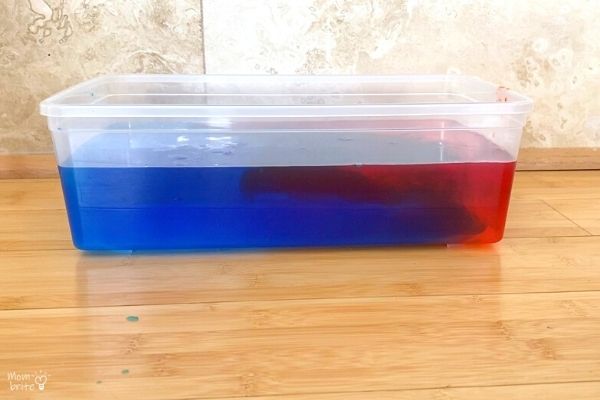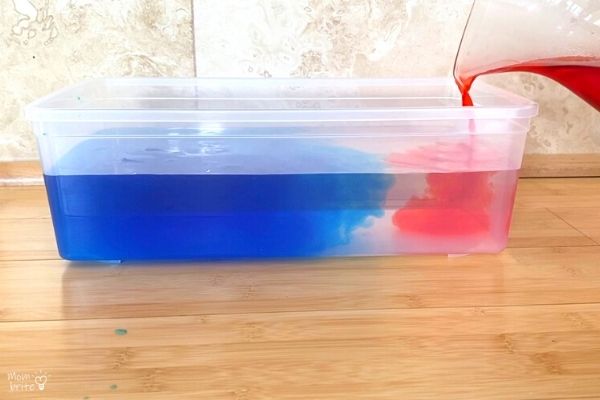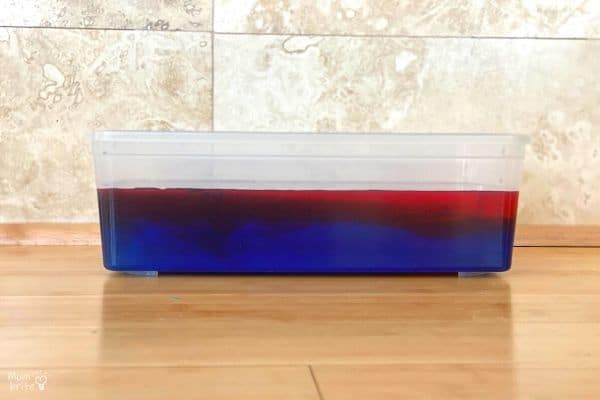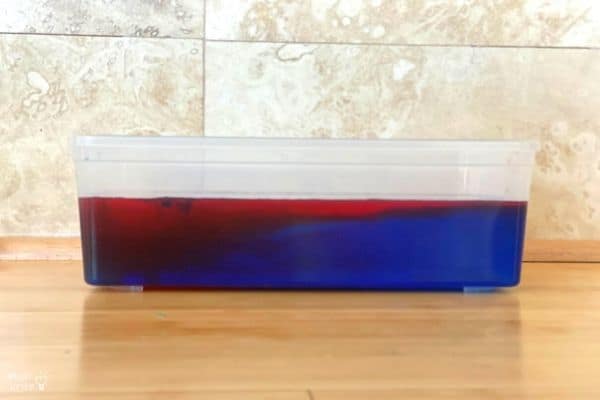Why does warm air rise and cold air sink? This easy science experiment demonstrates how the behavior of warm and cold air causes thunderstorms to form by using colored hot and cold water.

During the tornado in a bottle experiment, we learned that most tornadoes form from thunderstorms. Of course, with the curious minds that they have, my kids asked, “how do thunderstorms form?”
To understand how thunderstorms come about, you need to first understand that warm air rises and cold air sinks due to the difference in density. This thunderstorm convection experiment will demonstrate how this phenomenon happens with warm and cold water.
Why Do Warm Air Rise and Cold Air Sink?
Materials:
- Water
- Ice cube tray
- Blue and red food coloring
- 2 cups
- Large container
Instructions:
1. Add blue food coloring to tap water and pour the colored water in an ice cube tray. Leave the tray in the freezer for at least 3 hours or overnight to make colored ice cubes. Alternatively, you can just chill the water in the fridge without making ice but make sure the blue water is much colder than room temperature.
2. Pour warm water (you can heat the water on a stovetop or microwave) into a cup. Add red food coloring and mix.
3. Take out the blue ice cubes and place them in a separate cup.
4. Fill the large container with room temperature water.
5. Pour the blue ice cubes into one end of the tank.
6. Pour the red warm water into the other end of the tank.

7. Watch the blue water quickly sinking to the bottom of the container while the red floats on top!

We were excited to do this experiment and probably poured way too much of the cold, blue water in the container. Even so, you can see how the cold water sunk to the bottom and warm water remained on top.
Even after we left the container alone for 10 minutes or so, the separation between the two colors remained. You could see a little bit of mixing in the middle layer where the two colors met, but the top remained red and the bottom blue.
The separation of colors was due to the difference in water density. The cold water was denser than the warm water, and therefore it sank to the bottom. This also holds true for warm and cold air. Read below to see how this warm and cold water experiment helps your kids understand thunderstorms.
Science Behind the Thunderstorm Formation Experiment
For thunderstorms to happen, you need moist, warm air, typically from the ocean. Instability forms when warm, moist air is near the ground and cold, dry air is up higher in the atmosphere.
Warm air rises and until it reaches a similar temperature as the air around it. Then, as we see in the cloud in a jar experiment, the water vapor in the warm air will condense into a cloud.
When water vapor condenses, it releases heat. Therefore, the warm air continues to rise, forming taller and taller clouds.
When it’s hot out, the abundant heat gives the air a strong impulse to rise. Combined with the high moisture in the air, this causes the formation of a lot of clouds.
All of this causes strong upward winds (updraft) and downward winds (downdraft). This is the stage at which tornadoes can form. Make sure you check out the tornado in a bottle experiment to give your kids a safe visualization of the tornado!
The updrafts continue to push the warm air upward until eventually the updrafts fade and the thunderstorm slows down.

If you like weather experiments, also check out rain in a jar where you can create beautiful rain at home!

great experiment.
thank you!